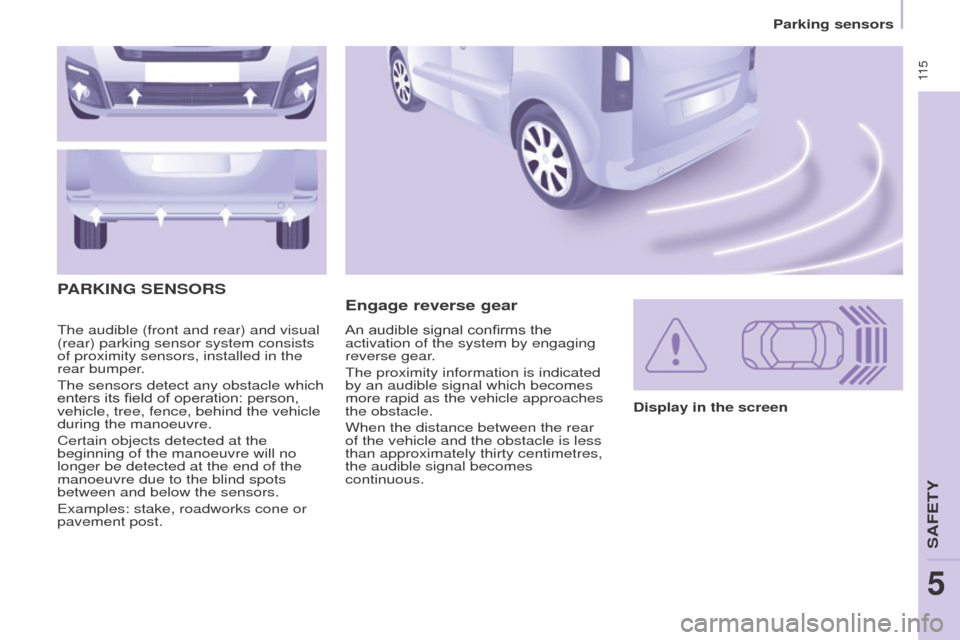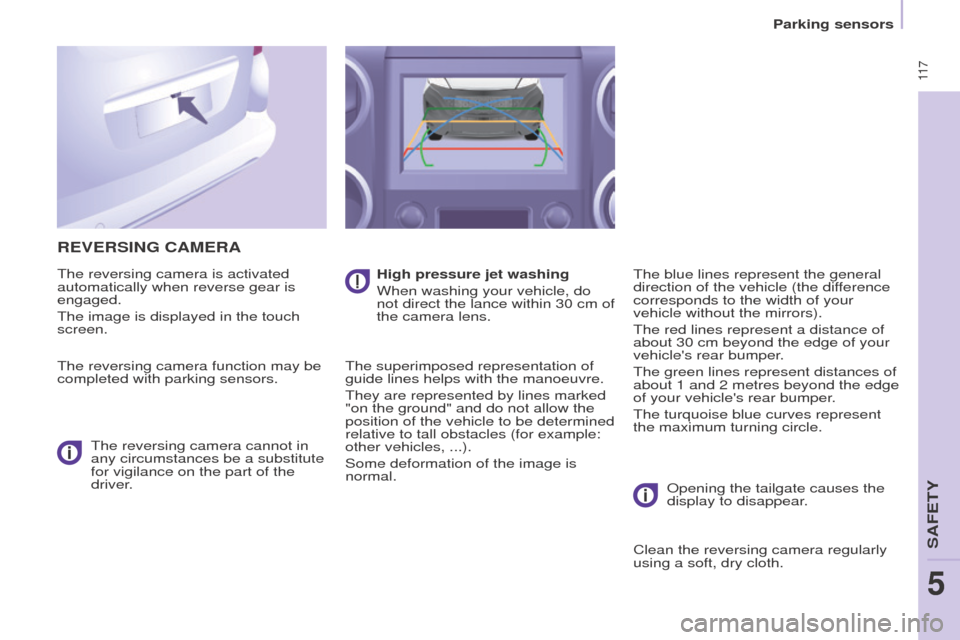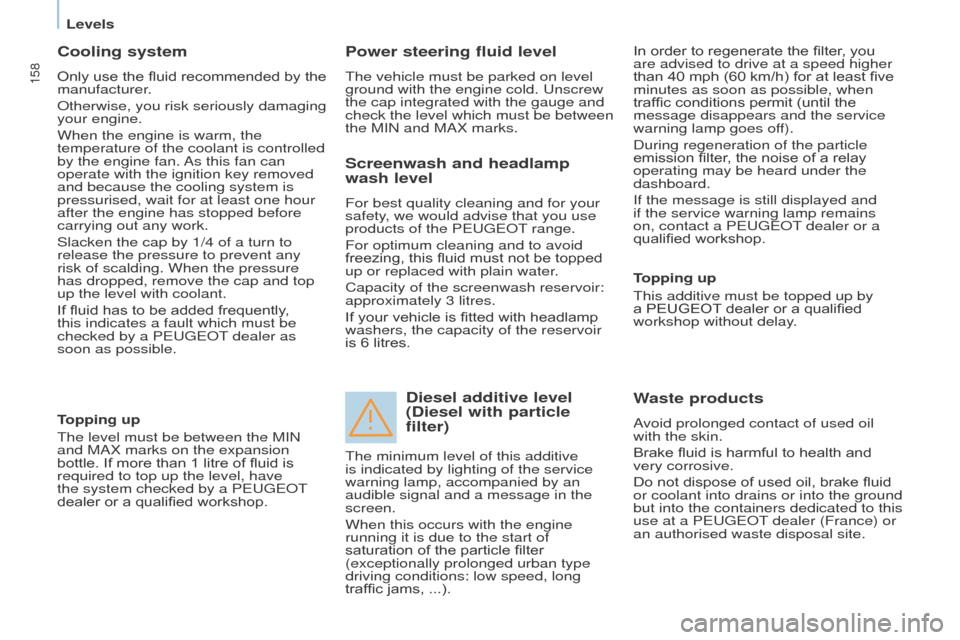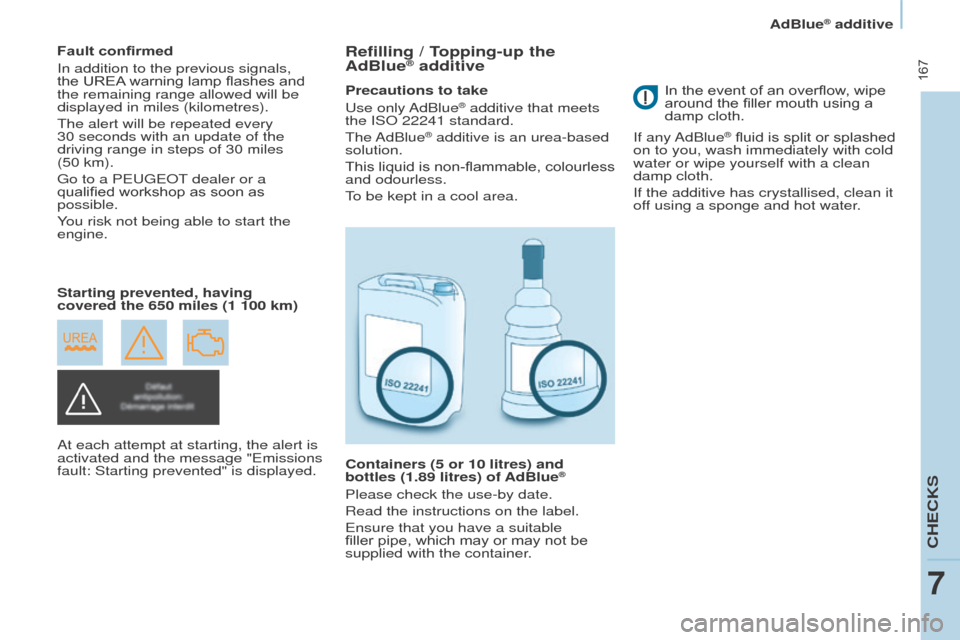display Peugeot Partner Tepee 2016 Owner's Guide
[x] Cancel search | Manufacturer: PEUGEOT, Model Year: 2016, Model line: Partner Tepee, Model: Peugeot Partner Tepee 2016Pages: 296, PDF Size: 10.76 MB
Page 117 of 296

11 5
The audible (front and rear) and visual
(rear) parking sensor system consists
of proximity sensors, installed in the
rear bumper.
The sensors detect any obstacle which
enters its field of operation: person,
vehicle, tree, fence, behind the vehicle
during the manoeuvre.
Certain objects detected at the
beginning of the manoeuvre will no
longer be detected at the end of the
manoeuvre due to the blind spots
between and below the sensors.
e
xamples: stake, roadworks cone or
pavement post.
engage reverse gear
P
ARKIN
g
S
e
NS
o
RS
Display in the screen
An audible signal confirms the
activation of the system by engaging
reverse gear.
The proximity information is indicated
by an audible signal which becomes
more rapid as the vehicle approaches
the obstacle.
When the distance between the rear
of the vehicle and the obstacle is less
than approximately thirty centimetres,
the audible signal becomes
continuous.
SAFeTY
5
Parking sensors
5
Page 119 of 296

11 7
ReVeRSINg CAMeRA
The reversing camera is activated
automatically when reverse gear is
engaged.
The image is displayed in the touch
screen.
The reversing camera function may be
completed with parking sensors.The reversing camera cannot in
any circumstances be a substitute
for vigilance on the part of the
driver. High pressure jet washing
When washing your vehicle, do
not direct the lance within 30 cm of
the camera lens.
The superimposed representation of
guide lines helps with the manoeuvre.
They are represented by lines marked
"on the ground" and do not allow the
position of the vehicle to be determined
relative to tall obstacles (for example:
other vehicles,
...).
Some deformation of the image is
normal. The blue lines represent the general
direction of the vehicle (the difference
corresponds to the width of your
vehicle without the mirrors).
The red lines represent a distance of
about 30 cm beyond the edge of your
vehicle's rear bumper.
The green lines represent distances of
about 1 and 2 metres beyond the edge
of your vehicle's rear bumper.
The turquoise blue curves represent
the maximum turning circle.
o
pening the tailgate causes the
display to disappear.
Clean the reversing camera regularly
using a soft, dry cloth.
SAFeTY
5
Parking sensors
5
Page 125 of 296

123
operation
When your vehicle is too close to or
approaches the vehicle ahead too
quickly the system automatically
applies the brakes to avoid a collision.
You are then alerted by the display of a
message.
The brake lamps on your vehicle come
on to warn other road users.
The collision can be avoided
automatically if the difference in speed
between your vehicle and the vehicle
ahead does not exceed 9 mph
(15 km/h).
Above this threshold, the system will
do what is possible to avoid or reduce
the accident by lowering the speed of
impact.
The automatic braking may bring
the vehicle to a complete stop if the
situation requires it.
In this case, the vehicle is held
stationary temporarily (for about
1.5 seconds) to allow the driver to take
back control by pressing the brake
pedal.The triggering of the system may
cause the engine to stall, unless
the driver depresses the clutch
pedal quickly enough during automatic
braking.
During automatic braking, the
driver can always obtain a higher
rate of deceleration than that
controlled by the system, by pressing
firmly on the brake pedal.
After an impact, the system is
automatically put out of service: it
no longer operates.
You must go to a P
eugeo T dealer
or a qualified workshop to have the
system made operational again.
operating limits
The system only detects vehicles that
are stationary or moving in the same
direction as your vehicle.
It does not detect small vehicles
(bicycles, motorcycles),
pedestrians or animals, nor non-
reflective stationary objects.
The system is not triggered or is
interrupted if the driver:
-
accelerates strongly
-
or turns the steering wheel
suddenly (avoiding manoeuvre). In difficult weather conditions (very
heavy rain, snow
, fog, hail...),
braking distances increase, which
can reduce the ability of the system to
avoid a collision.
The driver must therefore remain
particularly vigilant.
Never leave accumulations of
snow or any object projecting
above the bonnet or in front of
the roof: this might fall into the field of
vision of the sensor and generate a
detection.
Driving safely
SAFeTY
5
Page 126 of 296

124
Deactivation
The system is deactivated in the
vehicle configuration menu, accessible
with the ignition on.
Its state is memorised when the
ignition is switched off.When the system is deactivated,
a message is displayed every
time the ignition is switched on,
to
warn you. With the monochrome screen C
F
Press the
M e N u button for access
to the main menu.
F
Select "
Personalisation-
Configuration".
F
Select "
Define vehicle
parameters".
F
Select "
Driving assistance".
F
Select "
Automatic emergency
braking:
o FF" or "Automatic
emergency braking:
o N".
F
Press the "
7" or "8" button to
check or uncheck the box and
activate or deactivate the system
respectively.
F
Press the "
5" or "6" button, then
the
o K button to select the " o K"
box and confirm or the Back button
to cancel. With the touch screen
F
Press the "M e N u " button.
F Select the " Driving" menu.
F
In the secondary page, select
"
Vehicle settings".
F
Select "
Driving assistance" tab.
F
Check or uncheck the "
Automatic
emergency braking" box to
activate or deactivate the system.
F
Confirm.
Driving safely
Page 127 of 296

125
operating faults
Sensor fault
The operation of the laser sensor may
suffer interference from accumulations
of dirt or misting of the windscreen.
In this case you are warned by the
display of a message.
u
se the windscreen demisting
and regularly clean the area of the
windscreen in front of the sensor.
Do not stick or otherwise fix any
object on the windscreen in front
of the sensor. System fault
In the event of a malfunction of the
system, you are warned by an audible
signal and the display of the message
"Automatic braking system fault".
Have the system checked by a
PEUGEOT dealer or a qualified
workshop.
In the event of an impact to
the windscreen at the sensor,
deactivate the system and contact
a PEUGEOT dealer or a qualified
workshop
to
have your windscreen
replaced.
Never try to remove, adjust or test
the sensor.
o
nly a P eugeo T dealer or a
qualified workshop is able to work
on the system.
When towing a trailer or when the
vehicle is being towed, the system
must be deactivated.
Driving safely
SAFeTY
5
Page 160 of 296

158
Cooling system
Only use the fluid recommended by the
manufacturer.
o
therwise, you risk seriously damaging
your engine.
When the engine is warm, the
temperature of the coolant is controlled
by the engine fan. As this fan can
operate with the ignition key removed
and because the cooling system is
pressurised, wait for at least one hour
after the engine has stopped before
carrying out any work.
Slacken the cap by 1/4 of a turn to
release the pressure to prevent any
risk of scalding. When the pressure
has dropped, remove the cap and top
up the level with coolant.
If fluid has to be added frequently,
this indicates a fault which must be
checked by a P
eugeo T dealer as
soon as possible.
Power steering fluid level
The vehicle must be parked on level
ground with the engine cold. u nscrew
the cap integrated with the gauge and
check the level which must be between
the MIN and MAX marks. In order to regenerate the filter, you
are advised to drive at a speed higher
than 40 mph (60 km/h) for at least five
minutes as soon as possible, when
traffic conditions permit (until the
message disappears and the service
warning lamp goes off).
During regeneration of the particle
emission filter, the noise of a relay
operating may be heard under the
dashboard.
If the message is still displayed and
if the service warning lamp remains
on, contact a P
eugeo T dealer or a
qualified workshop.
topping up
The level must be between the MIN
and MAX marks on the expansion
bottle. If more than 1 litre of fluid is
required to top up the level, have
the system checked by a P
eugeo
T
dealer or a qualified workshop.
Screenwash and headlamp
wash level
For best quality cleaning and for your
safety, we would advise that you use
products of the P
eugeo T range.
For optimum cleaning and to avoid
freezing, this fluid must not be topped
up or replaced with plain water.
Capacity of the screenwash reservoir:
approximately 3 litres.
If your vehicle is fitted with headlamp
washers, the capacity of the reservoir
is 6 litres.
Diesel additive level
(Diesel with particle
filter)
topping up
This additive must be topped up by
a PEUGEOT
dealer or a qualified
workshop without delay.
Waste products
Avoid prolonged contact of used oil
with the skin.
Brake fluid is harmful to health and
very corrosive.
Do not dispose of used oil, brake fluid
or coolant into drains or into the ground
but into the containers dedicated to this
use at a P
eugeo T dealer (France) or
an authorised waste disposal site.
The minimum level of this additive
is indicated by lighting of the service
warning lamp, accompanied by an
audible signal and a message in the
screen.
When this occurs with the engine
running it is due to the start of
saturation of the particle filter
(exceptionally prolonged urban type
driving conditions: low speed, long
traffic jams, ...).
Levels
Page 166 of 296

164
good practice
While the quantity of AdBlue® in
the additive tank is sufficient, no
information is displayed.
o
n the other hand, once the additive
level drops to the quantity needed
for a range of 1 500 miles (2 400 km)
driving, you are warned by different
temporary signals (warning lamp,
message, audible signal).
As more miles are covered, these
signals intensify and the message
becomes permanent.
When the AdBlue
® tank is empty,
restarting becomes impossible.
It is strongly recommended that you
do not wait for the successive alerts
before topping-up the AdBlue
® tank,
but do this as soon as possible.
Filling the additive tank
For light vehicles, 5 or 10 litre
containers and 1.89 litre (1/2
u
S gallon)
bottles are available from P
eugeo
T
dealers, until they are equipped with
AdBlue
® delivery pumps.
If you want to fill the AdBlue® tank
yourself, ensure that you have a
suitable filler pipe, which may or may
not be supplied with the additive
container.
AdBlue® additive
Page 167 of 296

165
Range indicators
Rules on the display of alertsFor more information on the
displays and warning lamps, refer
to chapter 3, "Instruments and
controls" section. Range greater than 1 500 miles
(2 400 km)
No information displayed.
o
nce the 1 500 miles (2 400 km)
threshold is reached, the
u R e A
warning lamp comes on temporarily
and the remaining range message is
displayed.
The alert is repeated every 200 miles
(300 km) until the next threshold is
reached.
e
very time the ignition is switched
on, the alert is given, together with an
audible signal. Remaining range less than 1 500
miles
(2 400 km) and greater than 350 miles
(600 km)
Driving range
With the touch screen:
If the range is greater than 3 000 miles
(5 000 km), a range value is not given. Press this button to display
the information.
-
select the "Driving
assistance" menu,
-
select "Diagnostic",
-
select CH
e CK.
Different levels of alert are triggered
according to the remaining driving
range threshold
You will be informed as each mileage
threshold is reached and the alerts will
change from temporary to permanent.
-
The 1st is triggered at a remaining
driving range of 1 500 miles
(2 400 km).
-
The 2nd is triggered at a remaining
driving range of 350 miles (600 km).
-
u
p to 0 miles, at which point it will
be impossible to restart the engine
after a stop.
CHeCKS
7
AdBlue® additive
Page 169 of 296

167
Fault confirmed
In addition to the previous signals,
the UREA warning lamp flashes and
the remaining range allowed will be
displayed in miles (kilometres).
The alert will be repeated every
30 seconds with an update of the
driving range in steps of 30 miles
(50 km).
g
o to a P eugeo T dealer or a
qualified workshop as soon as
possible.
You risk not being able to start the
engine.
Starting prevented, having
covered the 650 miles (1 100 km)
At each attempt at starting, the alert is
activated and the message "
e missions
fault: Starting prevented" is displayed.Refilling / topping-up the
AdBlue® additive
Precautions to take
u
se only AdBlue® additive that meets
the IS
o
22241 standard.
The AdBlue
® additive is an urea-based
solution.
This liquid is non-flammable, colourless
and odourless.
To be kept in a cool area.
Containers (5 or 10 litres) and
bottles (1.89 litres) of AdBlue
®
Please check the use-by date.
Read the instructions on the label.
e
nsure that you have a suitable
filler pipe, which may or may not be
supplied with the container. In the event of an overflow, wipe
around the filler mouth using a
damp cloth.
If any AdBlue
® fluid is split or splashed
on to you, wash immediately with cold
water or wipe yourself with a clean
damp cloth.
If the additive has crystallised, clean it
off using a sponge and hot water.
CHeCKS
7
AdBlue® additive
Page 203 of 296

2017-inch touch screen
gPS satellite navigation - Multimedia audio - Bluetooth® telephone
Contents
First steps
2 02
Steering mounted controls
20
4
Menus
205
Navigation
2
06
Navigation -
g
u
idance
2
14
Tr a f fi c
2
18
Radio Media
2
20
Radio
2
26
DAB (Digital Audio Broadcasting) radio
2
28
Media
230
Settings
234
Connected services
2
42
Internet browser
2
43
MirrorLink
TM 24 6
CarPlay® 250
T
elephone
254
Frequently asked questions
2
62
The system is protected in such a way that it will only operate in
your vehicle. As a safety measure, the driver should only carry out operations
which require prolonged attention while the vehicle is stationary.
The display of the energy economy mode message signals
that the system is about to go into standby. Refer to the
e
n
ergy
economy (mode) section.
Audio and Telematics
TeCHNoLogY on BoARD
10